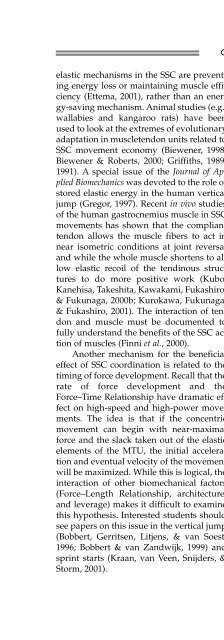Fundamentals of Biomechanics
Fundamentals of Biomechanics
Fundamentals of Biomechanics
You also want an ePaper? Increase the reach of your titles
YUMPU automatically turns print PDFs into web optimized ePapers that Google loves.
elastic mechanisms in the SSC are preventing<br />
energy loss or maintaining muscle efficiency<br />
(Ettema, 2001), rather than an energy-saving<br />
mechanism. Animal studies (e.g.,<br />
wallabies and kangaroo rats) have been<br />
used to look at the extremes <strong>of</strong> evolutionary<br />
adaptation in muscletendon units related to<br />
SSC movement economy (Biewener, 1998;<br />
Biewener & Roberts, 2000; Griffiths, 1989;<br />
1991). A special issue <strong>of</strong> the Journal <strong>of</strong> Applied<br />
<strong>Biomechanics</strong> was devoted to the role <strong>of</strong><br />
stored elastic energy in the human vertical<br />
jump (Gregor, 1997). Recent in vivo studies<br />
<strong>of</strong> the human gastrocnemius muscle in SSC<br />
movements has shown that the compliant<br />
tendon allows the muscle fibers to act in<br />
near isometric conditions at joint reversal<br />
and while the whole muscle shortens to allow<br />
elastic recoil <strong>of</strong> the tendinous structures<br />
to do more positive work (Kubo,<br />
Kanehisa, Takeshita, Kawakami, Fukashiro,<br />
& Fukunaga, 2000b; Kurokawa, Fukunaga,<br />
& Fukashiro, 2001). The interaction <strong>of</strong> tendon<br />
and muscle must be documented to<br />
fully understand the benefits <strong>of</strong> the SSC action<br />
<strong>of</strong> muscles (Finni et al., 2000).<br />
Another mechanism for the beneficial<br />
effect <strong>of</strong> SSC coordination is related to the<br />
timing <strong>of</strong> force development. Recall that the<br />
rate <strong>of</strong> force development and the<br />
Force–Time Relationship have dramatic effect<br />
on high-speed and high-power movements.<br />
The idea is that if the concentric<br />
movement can begin with near-maximal<br />
force and the slack taken out <strong>of</strong> the elastic<br />
elements <strong>of</strong> the MTU, the initial acceleration<br />
and eventual velocity <strong>of</strong> the movement<br />
will be maximized. While this is logical, the<br />
interaction <strong>of</strong> other biomechanical factors<br />
(Force–Length Relationship, architecture,<br />
and leverage) makes it difficult to examine<br />
this hypothesis. Interested students should<br />
see papers on this issue in the vertical jump<br />
(Bobbert, Gerritsen, Litjens, & van Soest,<br />
1996; Bobbert & van Zandwijk, 1999) and<br />
sprint starts (Kraan, van Veen, Snijders, &<br />
Storm, 2001).<br />
CHAPTER 4: MECHANICS OF THE MUSCULOSKELETAL SYSTEM 91<br />
The most influential mechanism for the<br />
beneficial effect <strong>of</strong> an SSC will likely depend<br />
on the movement. Some events like<br />
the foot strike in sprinting or running jump<br />
(100 to 200 ms) require high rates <strong>of</strong> force<br />
development that are not possible from rest<br />
due to the Force–Time Relationship. These<br />
high-speed events require a well-trained<br />
SSC technique and likely have a different<br />
mix <strong>of</strong> the four factors than a standing vertical<br />
jump.<br />
Plyometric (plyo=more metric=length)<br />
training will likely increase the athlete's<br />
ability to tolerate higher eccentric muscle<br />
forces and increase the potentiation <strong>of</strong> initial<br />
concentric forces (Komi, 1986). Plyometrics<br />
are most beneficial for athletes in<br />
high-speed and power activities. There has<br />
been considerable research on the biomechanics<br />
<strong>of</strong> lower-body drop jumping plyometrics<br />
(Bobbert, 1990). Early studies<br />
showed that jumpers tend to spontaneously<br />
adopt one <strong>of</strong> two techniques (Bobbert,<br />
Makay, Schinkelshoek, Huijing, & van<br />
Ingen Schenau, 1986) in drop jumping exercises.<br />
Recent research has focused on technique<br />
adaptations due to the compliance <strong>of</strong><br />
the landing surface (Sanders & Allen, 1993),<br />
the effect <strong>of</strong> landing position (Kovacs et al.,<br />
1999), and what might be the optimal drop<br />
height (Lees & Fahmi, 1994). Less research<br />
has been conducted on the biomechanics <strong>of</strong><br />
upper body plyometrics (Newton, Kraemer,<br />
Hakkinen, Humphries, & Murphy,<br />
1996; Knudson, 2001c). Loads for plyometric<br />
exercises are controversial, with loads<br />
ranging between 30 and 70% <strong>of</strong> isometric<br />
muscular strength because maximum power<br />
output varies with technique and the<br />
movement (Cronin, McNair, & Marshall,<br />
2001a; Izquierdo, Ibanez, Gorostiaga,<br />
Gaurrues, Zuniga, Anton, Larrion, &<br />
Hakkinen, 1999; Kaneko, Fuchimoto, Toji,<br />
& Suei, 1983; Newton, Murphy, Humphries,<br />
Wilson, Kraemer, & Hakkinen, 1997;<br />
Wilson, Newton, Murphy, & Humphries,<br />
1993).






